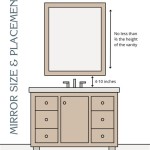How Wide Are Bathroom Stalls?
Bathroom stalls are essential for maintaining privacy and providing a comfortable space for individuals to use the restroom. The width of a bathroom stall is an important consideration for both accessibility and overall user experience. While there are no universally mandated dimensions, there are general guidelines and recommendations that vary depending on factors such as building type, usage, and local building codes.
Standard Stall Widths
The standard width for a bathroom stall is typically between 30 and 36 inches. This range allows for adequate space for individuals to comfortably enter and exit the stall, move around, and use the facilities without feeling cramped. The exact width may vary depending on the specific design and layout of the bathroom. For example, stalls in commercial restrooms might be slightly wider to accommodate larger crowds and a wider range of body types.
In addition to width, the depth of the stall is also important to ensure privacy and functionality. A standard stall depth is typically around 54 to 60 inches. This depth allows for adequate space for a toilet, sink, and even a small vanity or storage area in some cases. It also ensures that individuals have ample space to open and close the door without bumping into walls or fixtures.
Accessibility Considerations
For restrooms designed to be accessible to individuals with disabilities, the Americans with Disabilities Act (ADA) outlines specific requirements for stall width and other dimensions. According to the ADA, accessible stalls must have a minimum clear width of 36 inches. This wider stall width ensures that individuals using wheelchairs or mobility aids have enough space to maneuver and comfortably use the facilities.
The ADA also mandates a minimum depth of 60 inches for accessible stalls, allowing for wheelchair users to turn around comfortably within the stall. Additionally, the stall door must have a minimum clear opening width of 32 inches to accommodate wheelchair access. These accessibility requirements are crucial for ensuring that all individuals have equal access to restrooms and can use them with ease.
Factors Influencing Stall Width
Several factors can influence the width of bathroom stalls, including the type of building, the intended use, and local building codes. For example, stalls in high-traffic areas like shopping malls or airports might be wider to accommodate larger crowds and faster turnover. Similarly, stalls in schools and hospitals might have different dimensions based on the specific needs of their users.
Local building codes also play a significant role in determining stall dimensions. Some jurisdictions may have specific requirements for stall width based on factors such as the number of stalls in a restroom, the designated use of the building, and the overall size of the space. Building owners and contractors should consult with local building officials to ensure compliance with all relevant codes and regulations.
Conclusion
The width of bathroom stalls is an important consideration for both accessibility and user experience. While there are no universal standards, general guidelines and ADA requirements provide a framework for designing and constructing restrooms that cater to a diverse range of users. By understanding the factors that influence stall width and adhering to relevant codes and regulations, building owners and contractors can ensure that restrooms are comfortable, functional, and accessible for all individuals.

Typical Bathroom Partition Dimensions One Point Partitions

Toilet Stalls Upcodes

Ada Bathroom Layout Commercial Restroom Requirements And Plans

Ada Bathroom Requirements Restroom Space And Toilet Compartments Laforce Llc

Ada Guidelines For Bathroom Partitions Rex Williams

Ada Bathroom Requirements Restroom Space And Toilet Compartments Laforce Llc

Ada Guidelines For Bathroom Partitions Rex Williams

Toilet Partitions By The Numbers Height Partition Plus

Toilet Stalls Upcodes

Ada Bathroom Requirements Toilet Partitions
Related Posts







